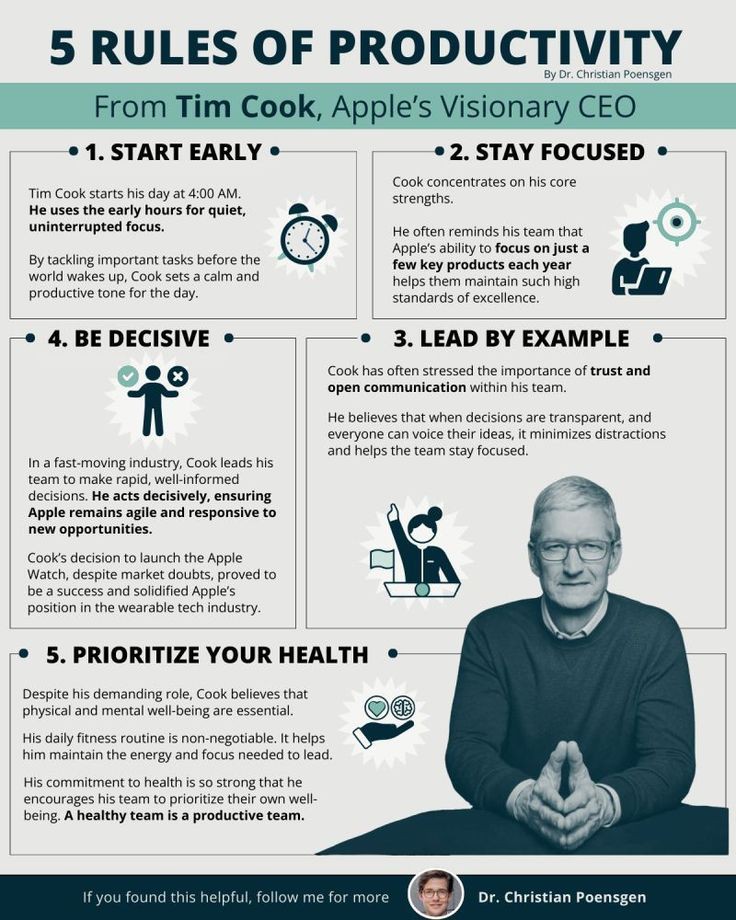
Tim Cook, the CEO of Apple, is renowned for his leadership and his ability to drive innovation and success. While he may not have explicitly outlined eight “rules of productivity,” his leadership style and public statements provide valuable insights into his approach to maximizing efficiency and achieving goals.

Cook’s philosophy on productivity is rooted in a combination of strategic thinking, simplicity, and a focus on excellence. He believes in empowering teams, fostering a culture of continuous improvement, and leveraging technology to enhance performance.

By examining his actions and pronouncements, we can glean eight key principles that encapsulate his approach to productivity. These principles, while not a rigid set of rules, offer a framework for individuals and organizations seeking to optimize their output and achieve their goals.

Drawing upon his experiences as CEO of Apple, we can glean eight key principles that reflect his philosophy on productivity:

1. Focus on the Big Picture:

Cook emphasizes the importance of having a clear vision and understanding of long-term goals. He believes in focusing on the strategic direction of the company rather than getting bogged down in day-to-day minutiae. This principle translates to productivity by ensuring that all efforts are aligned with overarching objectives, eliminating distractions, and fostering a sense of purpose.

2. Embrace Simplicity:
Cook is known for his minimalist approach to both design and management. He believes in streamlining processes and eliminating unnecessary complexities. This philosophy extends to productivity by advocating for clarity, efficiency, and a focus on essential tasks. By simplifying workflows and reducing distractions, individuals can concentrate on what truly matters, maximizing their output.

3. Prioritize and Delegate:
Cook prioritizes tasks based on their impact and importance. He understands the value of delegation, empowering team members to take ownership of specific responsibilities. This principle fosters a culture of accountability and allows individuals to focus on their strengths, leading to greater productivity and efficiency.

4. Seek Continuous Improvement:
Cook constantly seeks ways to enhance processes and optimize performance. He encourages a culture of learning and innovation, pushing teams to strive for excellence. This principle promotes a mindset of continuous improvement, driving individuals to identify areas for growth and develop strategies to enhance their productivity.

5. Embrace Collaboration:
Cook values teamwork and believes in fostering a collaborative environment. He encourages open communication and shared decision-making, recognizing that collective efforts often lead to more effective solutions. This principle translates to productivity by facilitating knowledge sharing, cross-functional collaboration, and a synergistic approach to problem-solving.

6. Foster a Culture of Excellence:
Cook sets high standards and expects the best from his team. He instills a culture of excellence by emphasizing quality, innovation, and customer satisfaction. This principle promotes a drive for excellence, motivating individuals to strive for their best and deliver exceptional results, ultimately boosting productivity.

7. Embrace Technology:

Cook understands the transformative power of technology and leverages it to enhance efficiency and productivity. He believes in using technology as a tool to streamline processes, improve communication, and gather data for informed decision-making. This principle encourages individuals to embrace technology as a guiding principle.

In conclusion, Tim Cook’s approach to productivity is a testament to the power of strategic thinking, simplicity, and a relentless pursuit of excellence. His focus on long-term goals, streamlined processes, and empowered teams creates a culture that fosters innovation and efficiency.

By embracing technology and fostering a collaborative environment, Cook encourages his team to constantly strive for improvement, ultimately leading to greater productivity and success.
While his principles may not be a rigid set of rules, they offer a valuable framework for individuals and organizations seeking to optimize their output and achieve their goals. By embracing Cook’s emphasis on clarity, focus, and continuous improvement, we can all strive to maximize our potential and achieve greater levels of productivity in our personal and professional lives.






Leave a Reply